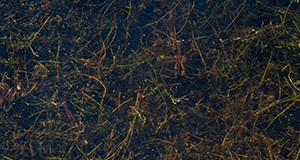Abstract
Hydrilla, which was originally introduced to the state as an aquarium plant, was intentionally planted in canals by aquarium plant dealers in the 1950s and quickly escaped cultivation. In addition to being one of the world’s worst aquatic weeds, the species is Florida’s most intensively managed submersed plant. Hydrilla is a federally listed noxious weed and a prohibited aquatic plant in Florida, making cultivation, sale, and possession of the species illegal. This 7-page fact sheet discusses the classification, characteristics, habitat, and management of hydrilla. Written by Lyn A. Gettys and Stephen F. Enloe, and published by the UF Agronomy Department, February 2016.
SS-AGR-400/AG404: Hydrilla: Florida's Worst Submersed Weed (ufl.edu)
References
Blackburn, R. D., L. W. Weldon, R. R. Yeo, and T. M. Taylor. 1969. "Identification and distribution of certain similar-appearing submersed aquatic weeds in Florida." Hyacinth Control Journal 8: 17-23.
CABI. 2015. "Hydrilla verticillata." In Invasive Species Compendium. Wallingford, UK: CAB International. Accessed July 26, 2015. http://www.cabi.org/isc/datasheet/28170
Cuda, J. P., B. R. Coon, E. N. I. Weeks, J. L. Gillmore, and T. D. Center. 2014. Hydrilla Tip Mining Midge: Cricotopus lebetis Sublette (Insecta: Diptera: Chironomidae). IN211. Gainesville: University of Florida Institute of Food and Agricultural Sciences. http://edis.ifas.ufl.edu/in211
Evans, J. M., and A. C. Wilkie. 2010. "Life cycle assessment of nutrient remediation and bioenergy production potential from the harvest of hydrilla (Hydrilla verticillata)." Journal of Environmental Management 91(12): 2626-2631. doi: 10.1016/j.jenvman.2010.07.040 https://doi.org/10.1016/j.jenvman.2010.07.040
FDACS DPI. 2010. "5B-64.011: Prohibited aquatic plants." Florida Department of State Florida Administrative Code & Florida Administrative Register. Accessed August 1, 2015. https://www.flrules.org/gateway/RuleNo.asp?title=AQUATIC%20PLANT%20IMPORTATION,%20TRANSPORTATION,%20NON-NURSERY%20CULTIVATION,%20POSSESSION%20AND%20COLLECTION&ID=5B-64.011
Fishel, F. M. 2012. Federal Regulations Affecting Use of Pesticides. PI168. Gainesville: University of Florida Institute of Food and Agricultural Sciences. http://edis.ifas.ufl.edu/pi168
FWC. 2016. "Aquatic Plant Management Annual Reports." Invasive Plant Management. Accessed April 22, 2016. http://myfwc.com/wildlifehabitats/invasive-plants/
Gettys, L. A., W. T. Haller, and G. E. MacDonald. 2013. "Chapter 13: Herbicides in aquatic systems." In Herbicides -Current Research and Case Studies in Use, ed. A. Price, 329-351. http://dx.doi.org/10.5772/56015 https://doi.org/10.5772/56015
Glomski, L. M., and M. D. Netherland. 2012. "Does hydrilla grow an inch per day? Measuring short-term changes in shoot length to describe invasive potential." Journal of Aquatic Plant Management 50: 54-57.
Haller, W. T. 2014. "Chapter 13: Mechanical control of aquatic weeds." In Biology and Control of Aquatic Plants, A Best Management Practices Handbook: Third Edition, ed. L. A. Gettys, W. T. Haller, and D. G. Petty, 43-50. Marietta: Aquatic Ecosystem Restoration Foundation.
Joyner, T. 2011. "Family of drowned teen wants more safeguards at Clayton County International Park." Atlanta Journal-Constitution, January 21, 2011. Accessed September 13, 2015. http://www.ajc.com/news/news/local/family-of-drowned-teen-wants-more-safeguards-at-cl/nQprG/
Langeland, K. A. 1996. "Hydrilla verticillata (L. f.) Royle (Hydrocharitaceae), 'The perfect aquatic weed.'" Castanea 61(3): 293-304.
Leicht, J. 2013. "County commissioners address Lake Seminole hydrilla." WTVY4, July 18, 2013. Accessed September 29, 2015. http://www.wtvy.com/home/headlines/County-Commissioners-to-Establish-Committee-to-Deal-With-Lake-Seminole-Hydrilla--216000121.html
Madeira, P., T. Van, K. Steward, and R. Schnell. 1997. "Random amplified polymorphic DNA analysis of the phenetic relationships among world-wide accessions of Hydrilla verticillata." Aquatic Botany 59: 217-236. https://doi.org/10.1016/S0304-3770(97)00075-2
Misra, M. K., A. Panda, and D. Sahu. 2012. "Survey of useful wetland plants of south Odisha, India." Indian Journal of Traditional Knowledge 11(4): 658-666.
Robbins, S. 2015. "Drownings of immigrants crossing Rio Grande rise." Charleston Daily Mail, March 29, 2015. Accessed September 13, 2015. http://www.charlestondailymail.com/article/20150329/ARTICLE/150329157
Shelley, J. 1990. "Hydrilla plant poses danger for Lake Osborne swimmers." Sun-Sentinel (Broward County), June 20, 1990. Accessed September 13, 2015. http://articles.sun-sentinel.com/1990-06-20/news/9001140657_1_hydrilla-lake-operations-shallow-water
Sutton, D. L., V. V. Vandiver, Jr., and J. E. Hill. 2012. Grass Carp: A Fish for Biological Management of Hydrilla and Other Aquatic Weeds in Florida. FA043. Gainesville: University of Florida Institute of Food and Agricultural Sciences. http://edis.ifas.ufl.edu/fa043 https://doi.org/10.32473/edis-fa043-2012
UF IFAS CAIP. 2015. "Hydrilla: Hydrilla verticillata." University of Florida IFAS Center for Aquatic and Invasive Plants. Accessed October 22, 2015. http://plants.ifas.ufl.edu/node/183
USDA NRCS. 2015a. "Introduced, invasive, and noxious plants: Federal Noxious Weeds." United States Department of Agriculture Natural Resources Conservation Service. Accessed July 18, 2015. http://plants.usda.gov/java/noxious?rptType=Federal
USDA NRCS. 2015b. "Elodea canadensis Michx.: Canadian waterweed." United States Department of Agriculture Natural Resources Conservation Service. Accessed July 18, 2015. http://plants.usda.gov/core/profile?symbol=ELCA7
USEPA. 2012. "Federal Insecticide, Fungicide, and Rodenticide Act (FIFRA)." Accessed March 23, 2016. http://www.agriculture.senate.gov/imo/media/doc/FIFRA.pdf
Weeks, E. 2014. Hydrilla Tuber Weevil: Bagous affinis Hustache (Insecta: Coleoptera: Curculionidae). IN1039. Gainesville: University of Florida Institute of Food and Agricultural Sciences. http://edis.ifas.ufl.edu/in1039
Weeks, E., and J. Cuda. 2014. Hydrilla Leaf Mining Flies (Unofficial Common Name): Hydrellia spp. (Insecta: Diptera: Ephydridae). IN1034. Gainesville: University of Florida Institute of Food and Agricultural Sciences. http://edis.ifas.ufl.edu/in1034
Weeks, E., J. Cuda, and M. J. Grodowitz. 2014. Hydrilla Stem Weevil: Bagous hydrillae O'Brien. IN1036. Gainesville: University of Florida Institute of Food and Agricultural Sciences. http://edis.ifas.ufl.edu/in1036

